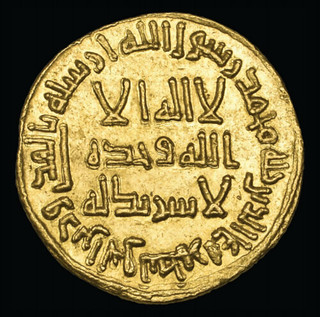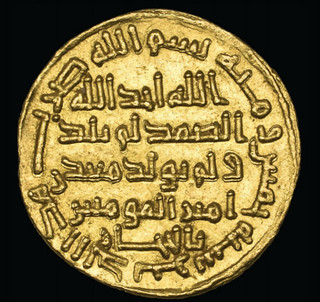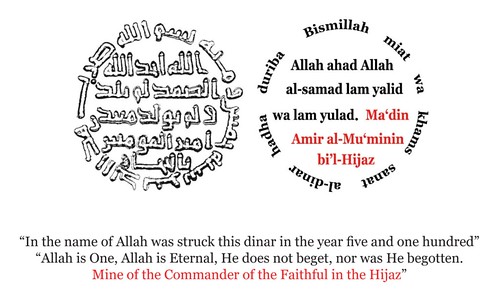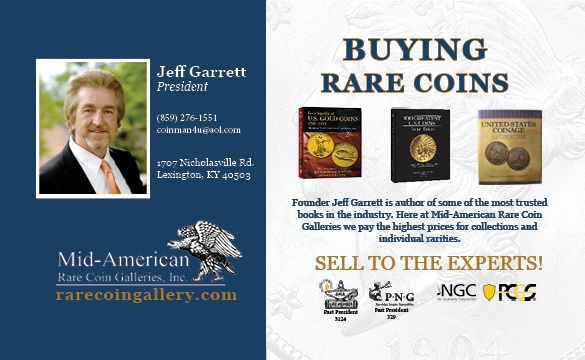
PREV ARTICLE
NEXT ARTICLE
FULL ISSUE
PREV FULL ISSUE
MINE OF THE COMMANDER OF THE FAITHFULAn important Islamic coin is coming up for sale in the October 24, 2019 Morton & Eden sale. Here's the lot description. -Editor   UMAYYAD, TEMP. HISHAM (105-125h)
Reverse: In field: Allah ahad Allah | al-samad lam yalid | wa lam yulad Ma'din | Amir al-Mu'minin | bi'l-Hijaz Weight: 4.27g References: Fahmy 128, same dies; Bernardi 48Ed; Walker ANS.16 = Miles, RIC 66 Good extremely fine, extremely rare and a historically important coin
Ex Baldwin's Islamic Coin Auction 19, 'Classical Rarities of Islamic Coinage,' 25 April 2012, lot 17. EXTREMELY RARE AND OF GREAT HISTORICAL INTEREST, dinars from the 'Mine of the Commander of the Faithful in the Hijaz' have the distinction of being the first Islamic coins to mention a location within the present Kingdom of Saudi Arabia. The inscription which makes this coin so special is not difficult to translate: Ma'din Amir al-Mu'minin bi'l-Hijaz simply means 'Mine of the Commander of the Faithful, in the Hijaz.' But while scholars continue to study its precise meaning and significance, there are strong grounds for believing that the gold used in their manufacture came from a mine located between the Holy Cities of Makka and al-Madina, which was itself owned not only by several caliphs but which had been given to another former owner by the Prophet himself.  The meaning of Ma'din in this context remains the subject of scholarly debate, because it can be used figuratively (much as one can describe someone as 'a mine of information' in English) as well as literally. But there are good reasons to accept that Ma'din refers to a place from which ores or metals are mined and recovered. This is certainly how the word is used on Abbasid silver dirhams struck less than a century later, on which the mint-name in the margin is given as Ma'din al-Shash or Ma'din Bajunays, meaning 'the mine at Tashkent' and 'the mine at Bajunays' respectively. Legends on other Umayyad coins are, without exception, either religious (verses from the Qur'an) or practical (information about where, and on some copper coins by whom, they were struck), and it is difficult to see why we should expect Ma'din Amir al-Mu'minin to be anything different. Amir al-Mu'minin, meaning 'Commander of the Faithful,' is a title which can only refer to the caliph himself. However, two caliphs held office during the year 105h, when Hisham (105-125h) succeeded Yazid II (101-105h). Is it possible to say which of these two caliphs amir al-mu'minin denotes? Yazid II appears to have been in Syria throughout this year, and probably died in Damascus (al-Tabari 1463). Hisham was also in Syria when he became caliph but must have travelled to the Holy Places soon afterwards, since we hear of him delivering a funeral speech at the cemetery near al-Madina later in the year 105h (al-Tabari 1472), and he remained in the region in 106h also. Since Hisham was in the Hijaz in the year when these remarkable coins were issued, while Yazid was not, we are probably justified in following Miles in believing that Hisham is the caliph mentioned here (Miles 1972, p.266). Remarkably, Miles was able to identify a very plausible candidate for exactly where the 'mine of the Commander of the Faithful in the Hijaz' may have been located. According to Miles, who built on earlier research by Paul Casanova, the caliph 'Umar (99-101h) purchased a mine called the Ma'din Bani Sulaym, located between Medina and Mecca. This mine had previously been held by the sons of Bilal al-Harith, who had been granted it the Prophet himself. According to Miles, 'Casanova quite reasonably argued that the mine became known as the Mine of the Amir al-Mu'minin and that Yazid II inherited it from his predecessor; hence the phrase amir al-mu'minin on the issue of 105 H' (Miles 1972, p.266). Given that Miles and Casanova had no difficulty accepting that Yazid could inherit the mine from 'Umar, there seems no reason to doubt that Hisham could have inherited it from Yazid in his turn. If so, then the mine mentioned on this coin not only belonged at least three caliphs, but had been bestowed on a previous owner by the Prophet himself. Thus the Ma'din amir al-mu'minin inscription seems best understood as indicating the origin of the gold used to strike these rare coins. No other mediaeval Islamic gold coin carries this information. Mediaeval Islamic gold coins often include the place of manufacture in the marginal legend with the date, but the actual source of the gold is not indicated. Why was it felt necessary to include this information on these dinars? One possibility is that there may have been an administrative reason: these coins were produced from gold which came from the caliph's private resources, rather than state revenues, and were marked as such for accounting purposes. But there are also grounds for believing that these coins were not only made from gold mined in the Hijaz, but were actually struck there too. The dies used on all Ma'din dinars were prepared in Damascus, and we know that the obverse die used to strike this very piece was also used to manufacture standard Umayyad dinars dated 105h. But travelling mints were not uncommon in the ancient world, and the simple tools needed to strike coins by hand were eminently portable. Workers and equipment from Damascus could have accompanied Hisham on his journey from Syria to the Hijaz in 105h, and a major pilgrim highway went right past the Ma'din Bani Sulaym - an inscription recording the rebuilding of this road in 304h was found among old mine-workings (Miles 1950). Thus the caliph might easily have taken the opportunity to visit his mine en route and strike a small quantity of special gold dinars bearing the Ma'din Amir al-Mu'minin bi'l-Hijaz legend. It is also possible that the raw gold was sent back to Damascus and the coins struck there, but this is harder to reconcile with the caliph's movements given that Hisham was still in Arabia in the year 106h and had not yet returned to Syria. Thus in this case it seems preferable to assume that these rare and fascinating coins were actually struck in the Hijaz region from gold mined there, making them the earliest Islamic gold coins to have been struck in present-day Saudi Arabia. Specialist References: Miles 1950 Miles, G.C., Rare Islamic Coins, ANS Numismatic Notes and Monographs 118, New York, 1950 Miles 1972 Miles, G.C., 'A Unique Umayyad dinar of 91h,' Revue Numismatique, 6e Serie, Tome 14 (1972), pp. 264-268 To read the complete catalog, see:
 Wayne Homren, Editor The Numismatic Bibliomania Society is a non-profit organization promoting numismatic literature. See our web site at coinbooks.org. To submit items for publication in The E-Sylum, write to the Editor at this address: whomren@gmail.com To subscribe go to: https://my.binhost.com/lists/listinfo/esylum All Rights Reserved. NBS Home Page Contact the NBS webmaster 
|